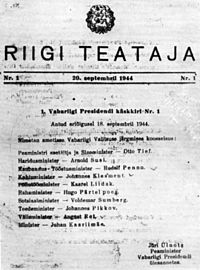- Otto Tief
-
Otto Tief Born 14 August 1889
Rapla, Rapla County, EstoniaDied 5 March 1976, Ahja Nationality Estonia Occupation Lawyer
Prime MinisterOtto Tief (14 August 1889, Rapla – 5 March 1976, Ahja) was a lawyer, an Estonian military commander during the Estonian War of Independence and a politician. He was Acting Prime Minister of the last government of Estonia[1][2] before Soviet troops occupied Estonia in 1944. Due to his commitment to his country, Otto Tief is regarded as a hero by many of his fellow countrymen.
Contents
Education and career
Tief studied law in St Petersburg between 1910 and 1916. During the Estonian War of Independence, Tief was a commander in the Kalevlaste Malev battalion formed in 1918 by members of the Kalev sports society. Following the war, he graduated in law from Tartu University in 1921. He served as legal counsel to the Estonian Land Bank and also worked in private practice as a lawyer. Tief was elected to the third Riigikogu in 1926 and served as the Minister of Social Affairs from 1926 to 1927. In 1928 he was the Minister of Justice. In 1932 he was elected to the fifth Riigikogu.
Otto Tief's Government of 1944
During the several days between the retreat of German occupation forces and the onslaught of the Red Army, acting President Jüri Uluots appointed Otto Tief as Prime Minister and asked him to form a government on 18 September 1944. Tief then published a proclamation reestablishing the independence of the Republic of Estonia on the basis of legal continuity, and attempted to organise a defence of Tallinn against the invading Red Army, which pushed into the capital on 22 September 1944.
Members of the Tief government
- Otto Tief – Acting Prime Minister and Minister of Interior
- Arnold Susi – Minister of Public Education
- Johannes Klesment (escaped to Sweden, assumed office 13 January 1945) – Minister of Justice
- Kaarel Liidak (died 16 January 1945) – Minister of Agriculture
- Hugo Pärtelpoeg (died 29 April 1951) – Minister of Finance
- Voldemar Sumberg – Minister of Social Affairs
- Juhan Pikkov (died 3 September 1947) – Minister of Communications
- August Rei (in Sweden, assumed office 31 December 1944, until 9 January 1945) – Minister of Foreign Affairs
- Juhan Kaarlimäe – Minister
- Johannes Sikkar (in Sweden, from 20 April 1952) – Minister
- Artur Terras (in Sweden, from 20 April 1952) – Minister
Aftermath
Otto Tief was arrested by the Soviet authorities on 10 October 1944. In 1945 he was sentenced to ten years imprisonment in the Siberian gulag. Returning to Estonia in 1956, he was forced to leave for the Ukraine until 1965, when he was permitted to return to the Baltic region to live just beyond the Estonian border in Latvia. When Otto Tief died on 5 March 1976, the Soviet security services would not allow his burial in the national cemetery in Tallinn. When Estonia had reattained her national independence in 1991, he was reinterred there in 1993, in the presence of a large number of people who came to remember and honor him.
Tief's symbolic significance
Tief only held power for only a brief period of time, and his efforts were rapidly undone by the invading Red Army. However, Tief's actions have immense symbolic and legal significance, as his proclaiming the restoration of the Republic of Estonia as well as the accompanying raising of the Estonian flag atop the tower of Pikk Hermann high above Tallinn at the seat of power in the Toompea quarter negate Soviet historiography's claims, according to which the 1944 Red Army invasion of the country constituted "liberation of Estonia".[3][4] Although the attempt to restore Estonian independence in September of 1944 did not succeed, the Otto Tief Government proved to be an integral and indispensable part of the de jure continuity of Estonia, upon which the current state rests.
Commemoration
In February 2007, the Riigikogu decided to commemorate the actions of Tief's government by proclaiming the 22 September to be the annual Day of Resistance. 22 September 1944 is the day, several days after the departure of Nazi Germany's occupying forces, that the invading Red Army took over the administrative centre of Tallinn, tore down the Estonian national flag and replaced it with the Red Flag, a symbol of Soviet occupation.[5]
References
- ^ The Otto Tief government and the fall of Tallinn
- ^ 22 September 1944: From one occupation to another
- ^ Postimees 18 September 2007: Ilves: Tiefi valitsus rikkus jutud Tallinna vabastamisest
- ^ The Baltic Times 19 September 2007: 'No difference' between Nazis and Soviets – Ilves
- ^ Postimees/ETV24 22 September 2007: Eesti tähistab esmakordselt vastupanuvõitlemise päeva
- (Estonian) Otto Tief, "Mälestusi aastaist 1944–1954" – Akadeemia 1990, nr. 2, lk. 231–250
Heads of Government of Estonia Chairman
of the Council of Ministers
Prime Ministers State Elders Prime Minister
in Duties of the State ElderPresident-Regent Prime Ministers Prime Ministers in Exile Prime Ministers Acting or Deputy Heads of Government · 1-later Soviet prisoner Categories:- Prime Ministers of Estonia
- Estonian people of World War II
- Rulers of Estonia
- Estonian War of Independence
- 1889 births
- 1976 deaths
- People from Rapla County
- Estonian prisoners and detainees
- Prisoners and detainees of the Soviet Union
Wikimedia Foundation. 2010.

